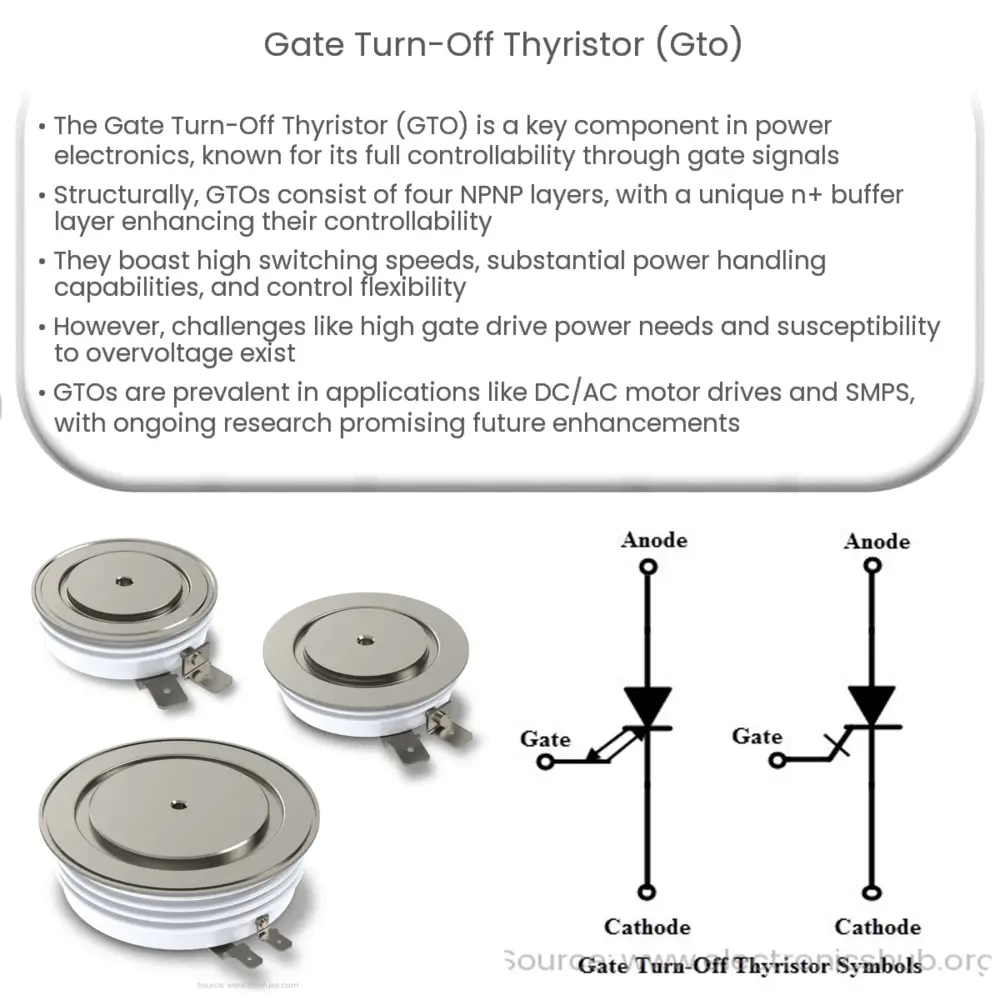Explore the world of Gate Turn-Off Thyristors (GTOs), their structure, operation, applications, and the future of power electronics.

Introduction to Gate Turn-Off Thyristor (GTO)
The Gate Turn-Off Thyristor (GTO) is a crucial component in the world of power electronics. This semi-conductor device, belonging to the thyristor family, carries the unique feature of being fully controllable. It implies that it can not only be turned on but also turned off by the application of a gate signal.
Structure and Principle of Operation
A GTO typically consists of four alternating layers of N and P type materials, labeled as NPNP. This structure is similar to the conventional thyristor but differs in the n+ buffer layer added to the cathode side in GTOs. This layer drastically reduces the turn-off time and increases the device’s controllability.
- Turning On: Similar to traditional thyristors, a GTO is turned on by applying a positive pulse to the gate terminal relative to the cathode. This action causes a forward-biased condition, which in turn leads to the flow of current.
- Turning Off: The standout feature of a GTO is its ability to turn off by applying a negative pulse to the gate terminal. The negative pulse forces the current carriers to be removed from the device, thus blocking the flow of current and turning off the device.
Characteristics of GTOs
GTOs exhibit several distinctive characteristics, making them desirable for various applications in power electronics. Some of the notable ones include:
- High Switching Speeds: GTOs have high switching speeds, which make them well-suited for applications requiring rapid on-off cycles.
- High Power Capability: These devices can handle high power levels, often up to several kilowatts, making them useful in high power applications.
- Control Flexibility: The ability to control the on-off state via the gate terminal gives GTOs a significant advantage over other power electronic devices.
Despite these advantages, GTOs also present a few challenges such as high gate drive power requirements, the need for snubber circuits, and susceptibility to damage due to overvoltage conditions. These limitations are crucial considerations while selecting GTOs for particular applications.
Applications of GTOs
GTOs find their use in various applications, especially those demanding high power and fast switching capabilities. Examples include:
- DC motor drives
- AC motor drives
- Induction heating
- Switched mode power supplies (SMPS)
These wide-ranging applications underline the importance of GTOs in the realm of power electronics.
Advancements and Future of GTOs
Since their inception, GTOs have undergone several advancements to overcome inherent challenges and improve performance. These include modifications in device structure, introduction of novel gate drive techniques, and the development of protective circuits. For example, the introduction of Integrated Gate-Commutated Thyristors (IGCTs) significantly reduced the gate drive power requirements, thus increasing the overall efficiency.
Despite the emergence of other power semiconductor devices such as Insulated Gate Bipolar Transistors (IGBTs) and Silicon Carbide (SiC) devices, GTOs continue to hold their ground in high power applications due to their superior power handling capabilities. The future of GTOs looks promising with continuous research and development efforts aimed at improving their performance and reliability.
Conclusion
In conclusion, the Gate Turn-Off Thyristor (GTO) is an integral part of the power electronics landscape. With its unique ability to be fully controlled via the gate terminal, high power handling, and fast switching speeds, it offers a compelling choice for many applications. However, as with any technology, it is not without its challenges. Overcoming these obstacles through continuous research and development is crucial for maximizing the potential of GTOs.
The future of GTOs is expected to see further improvements in device performance, reliability, and efficiency. As we continue to push the boundaries of power electronic devices, GTOs will undoubtedly play a pivotal role in shaping the future of power electronics.



